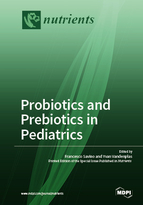Probiotics and Prebiotics in Pediatrics
A special issue of Nutrients (ISSN 2072-6643).
Deadline for manuscript submissions: closed (30 September 2018) | Viewed by 171585
Special Issue Editors
Interests: infant nutrition; breastmilk; infant formulas; leptin; ghrelin; infantile colic; gut microbiota; prebiotics
Special Issues, Collections and Topics in MDPI journals
Interests: milk; milk proteins; breastfeeding; infant
Special Issues, Collections and Topics in MDPI journals
Special Issue Information
Dear Colleagues,
The goal of this Special Issue, “Probiotics and Prebiotics in Pediatrics”, is to focus on the importance of pediatric nutrition with probiotics and prebiotics to improve gastrointestinal health in newborn, infants, and children.
Specifically, the aim is to clarify if probiotics and prebiotics can influence gut microbiota composition and host-interaction favoring human health and preventing diseases.
This new information will provide health care professionals with a widespread, clear and update evidence on probiotics and prebiotics and intestinal gut microbiota in pediatric care.
Dr. Francesco SavinoProf. Dr. Yvan Vandenplas
Guest Editors
Manuscript Submission Information
Manuscripts should be submitted online at www.mdpi.com by registering and logging in to this website. Once you are registered, click here to go to the submission form. Manuscripts can be submitted until the deadline. All submissions that pass pre-check are peer-reviewed. Accepted papers will be published continuously in the journal (as soon as accepted) and will be listed together on the special issue website. Research articles, review articles as well as short communications are invited. For planned papers, a title and short abstract (about 100 words) can be sent to the Editorial Office for announcement on this website.
Submitted manuscripts should not have been published previously, nor be under consideration for publication elsewhere (except conference proceedings papers). All manuscripts are thoroughly refereed through a single-blind peer-review process. A guide for authors and other relevant information for submission of manuscripts is available on the Instructions for Authors page. Nutrients is an international peer-reviewed open access semimonthly journal published by MDPI.
Please visit the Instructions for Authors page before submitting a manuscript. The Article Processing Charge (APC) for publication in this open access journal is 2900 CHF (Swiss Francs). Submitted papers should be well formatted and use good English. Authors may use MDPI's English editing service prior to publication or during author revisions.
Keywords
- prebiotics
- fructo-oligosaccharides
- galacto-oligosaccharides
- lactoferin
- probiotics
- gut microbiota
- E. Coli
- Lactobacilli
- infant nutrition








